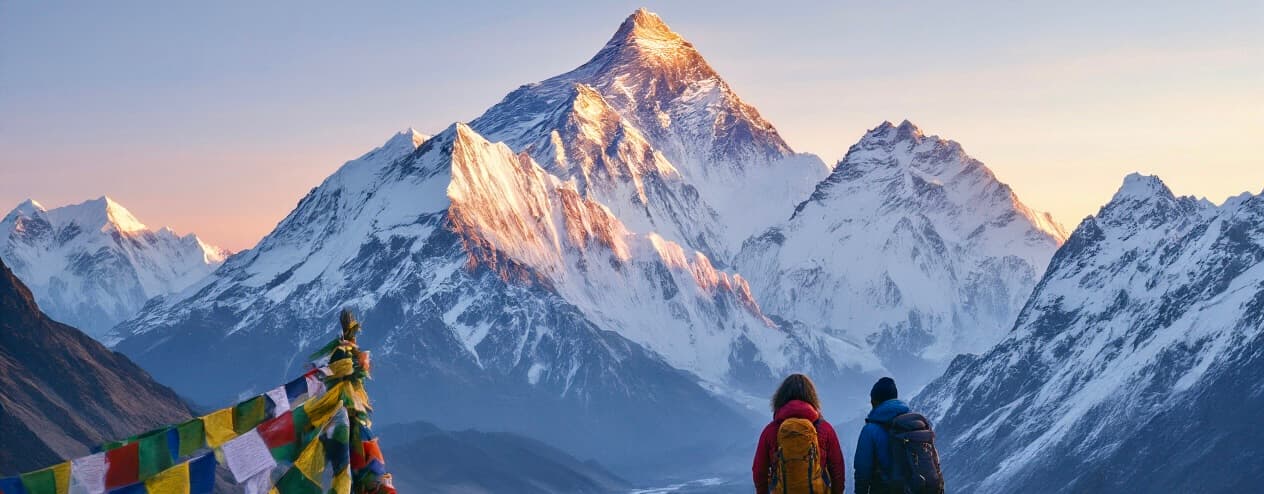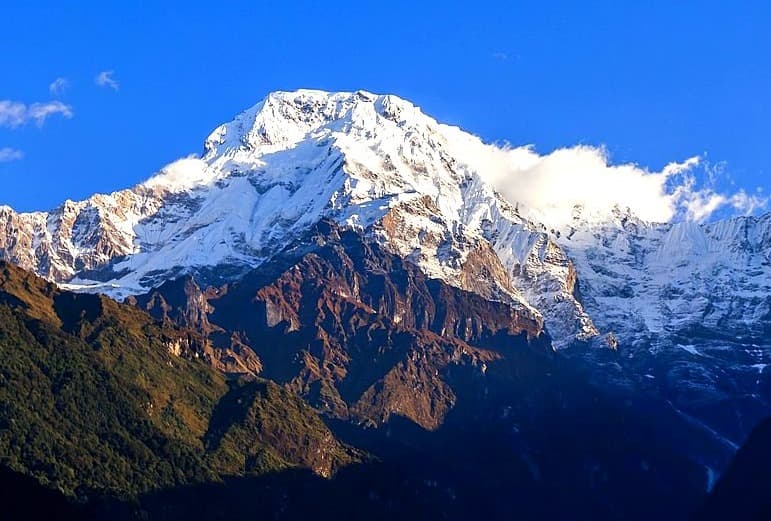Planning an Everest Base Camp trek? With several routes to the world's most famous base camp, choosing the right path makes all the difference in your Himalayan adventure. This guide from Luxury Holidays Nepal helps first-time trekkers and experienced hikers find their perfect EBC route. We'll cover the main trekking routes to Everest Base Camp, how to match a route to your fitness level, and what each season offers for your journey through the Khumbu region.
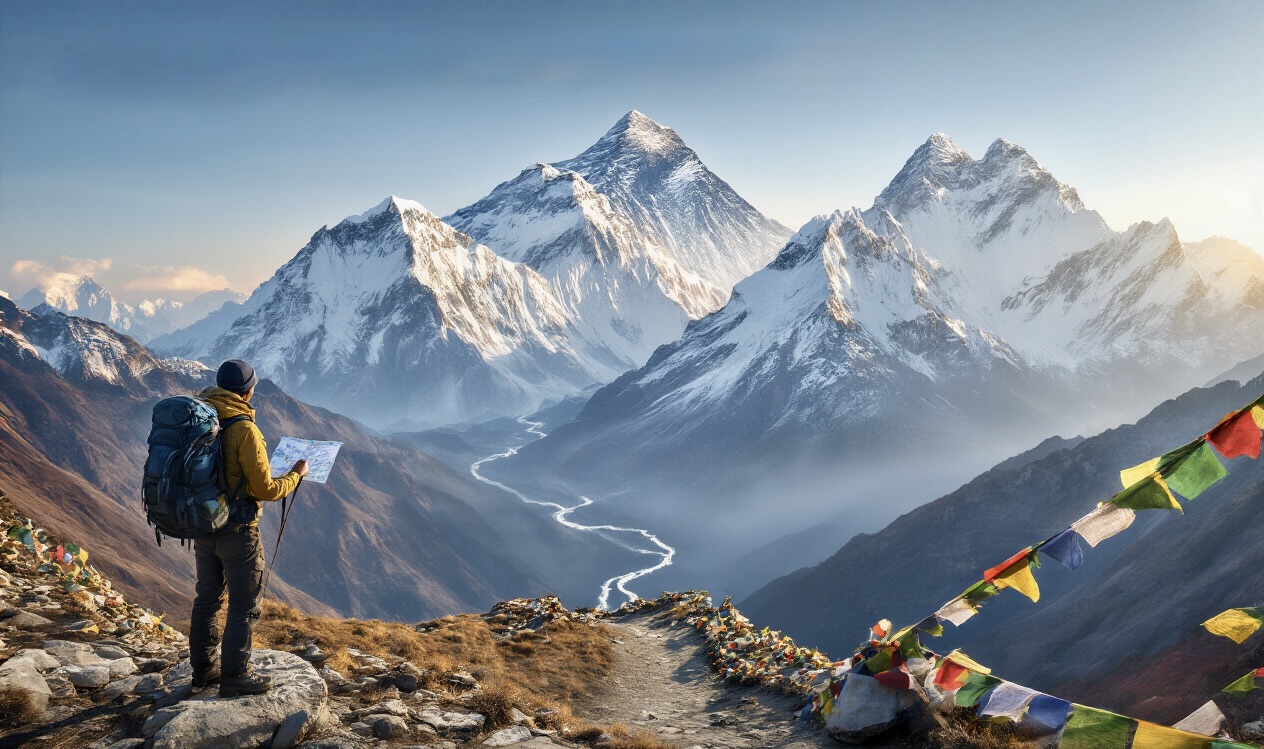
Understanding the Different Everest Base Camp Trek Routes
The journey to Everest Base Camp is a dream for many trekkers, but choosing the right route is crucial for a successful expedition. Each path offers unique experiences, challenges, and highlights that cater to different preferences and abilities.
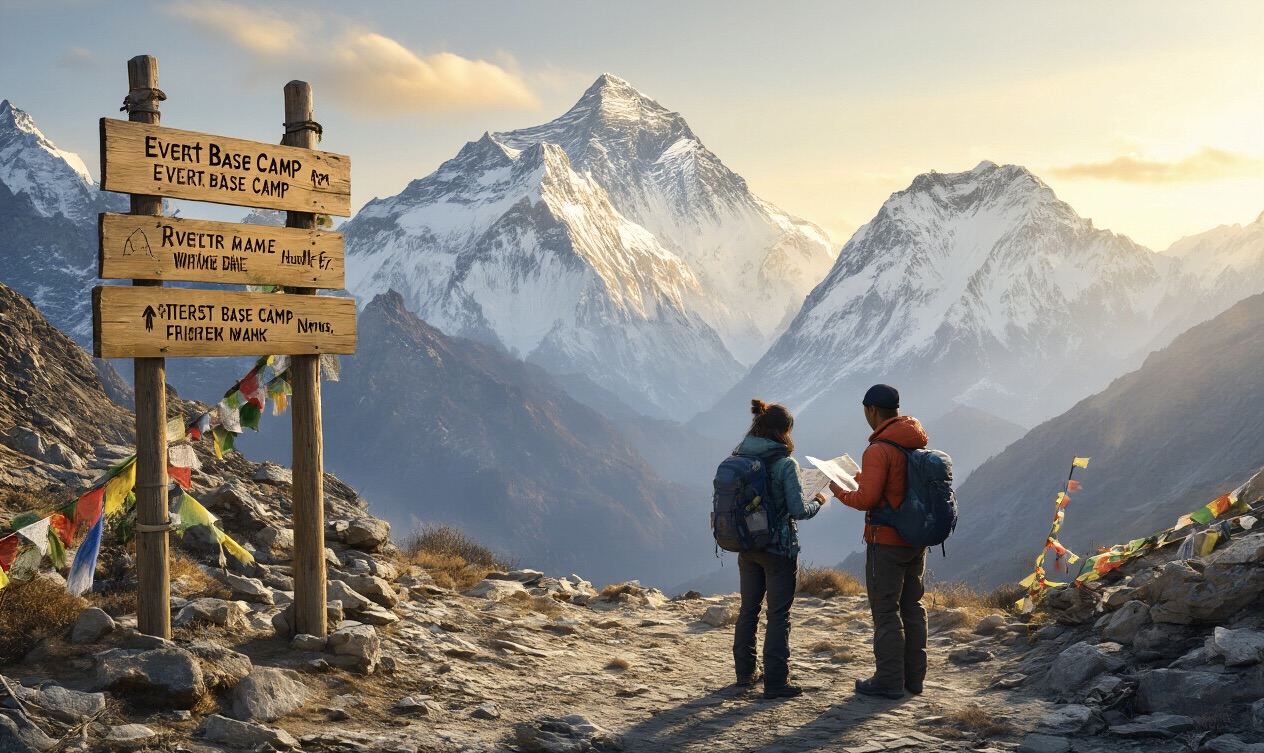
Classic EBC Trek via Lukla
The Classic Everest Base Camp route, beginning in Lukla, is the most popular choice for trekkers. Starting with a thrilling flight to Lukla's Tenzing-Hillary Airport, this well-established path follows the traditional route through charming Sherpa villages including Namche Bazaar, Tengboche, Dingboche, and Gorak Shep before reaching Everest Base Camp at 5,364 meters.
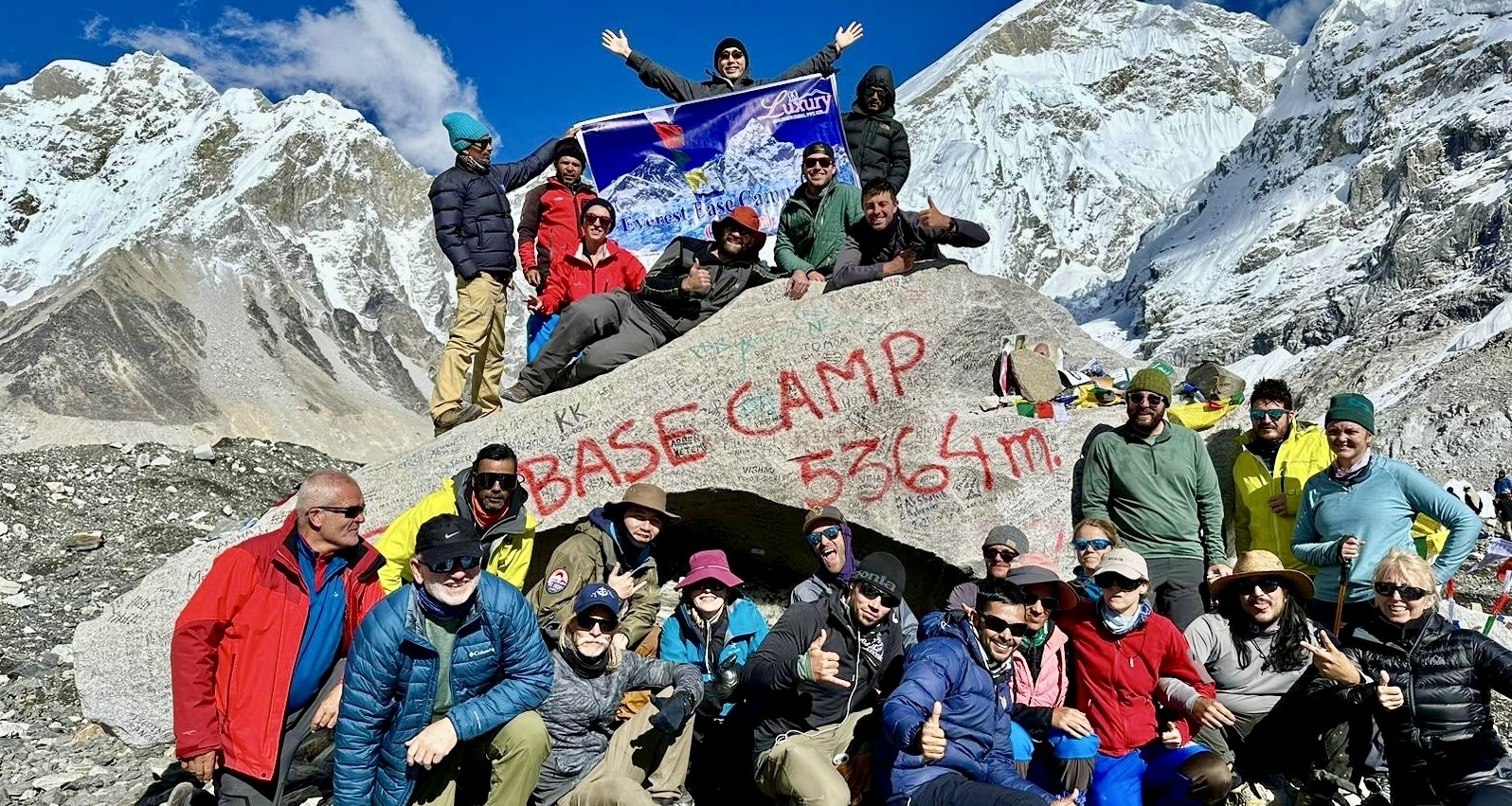
This route typically takes 12-14 days round trip and offers excellent infrastructure with teahouses and lodges at regular intervals. The path is well-marked and frequented by guides and fellow trekkers, making it ideal for first-time Himalayan adventurers. The classic route also includes highlights such as Namche Bazaar's vibrant market, Tengboche Monastery, and spectacular views of Everest, Lhotse, Nuptse, and Ama Dablam.
Gokyo Lakes Alternative Route
For those seeking a less crowded but equally stunning experience, the Gokyo Lakes route offers a magnificent alternative. This path diverges from the classic route at Namche Bazaar, heading northwest toward the turquoise Gokyo Lakes and the impressive Ngozumpa Glacier, the largest in the Nepalese Himalayas.
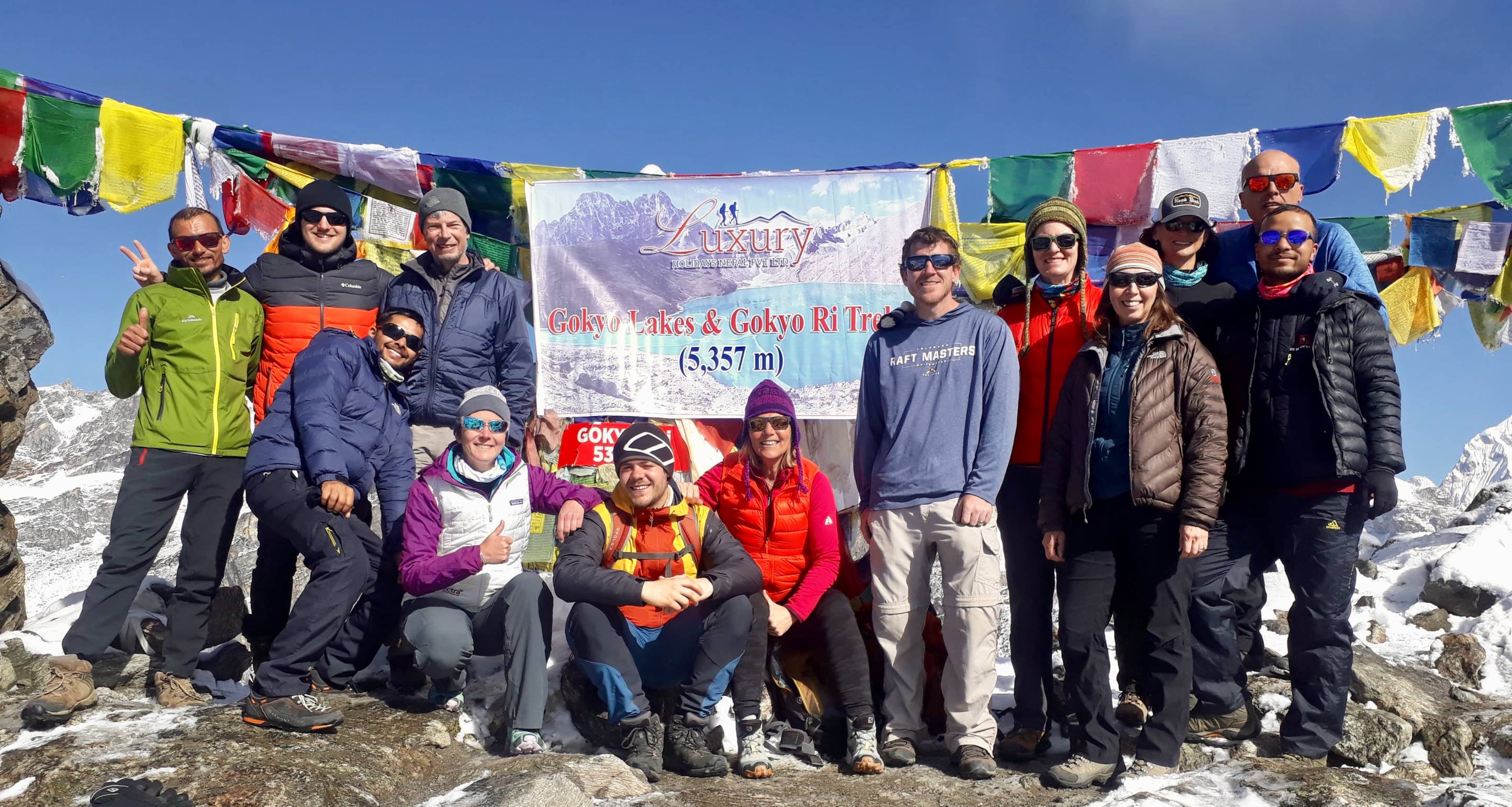
The Gokyo route features breathtaking panoramic views from Gokyo Ri (5,357m) that many trekkers consider superior to those from Kala Patthar on the classic route. This 14-16 day journey includes crossing the challenging Renjo La pass (5,360m) and provides spectacular vistas of four 8,000m peaks: Everest, Lhotse, Makalu, and Cho Oyu. The pristine alpine lakes surrounded by towering mountains create a magical landscape that feels worlds away from the busier main EBC trail.
Three Passes Trek for Advanced Trekkers
The Three Passes Trek is the ultimate challenge for experienced trekkers seeking a comprehensive Everest region experience. This demanding circuit crosses three high passes: Kongma La (5,535m), Cho La (5,420m), and Renjo La (5,360m), creating a complete loop of the Everest region.
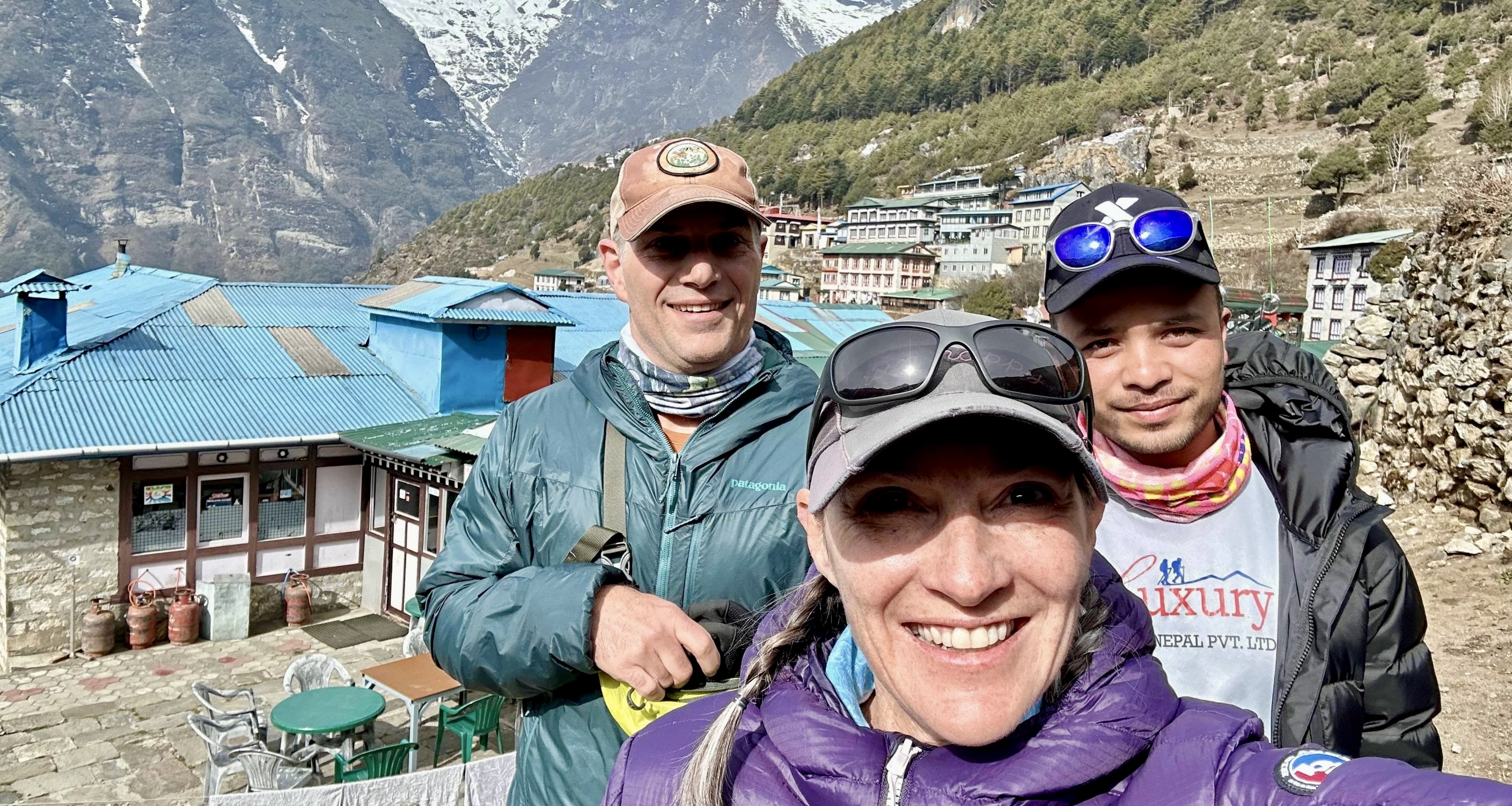
This 18-22 day adventure is physically demanding but incredibly rewarding, offering unparalleled diversity in landscapes and views. The route incorporates both the classic EBC trail and Gokyo Lakes while adding remote valleys and challenging high-altitude passes. Trekkers need excellent fitness, previous high-altitude experience, and proper acclimatization time. The Three Passes Trek provides the most comprehensive experience of the Everest region's geographical and cultural diversity, but requires serious preparation and experience.
Jiri to EBC Traditional Walking Route
For purists seeking to follow in the footsteps of early Everest expeditions, the Jiri to EBC route offers the traditional approach taken by Sir Edmund Hillary and Tenzing Norgay. Beginning with an 8-hour jeep ride from Kathmandu to Jiri, this route adds 5-7 extra days of trekking through the lower Khumbu region before joining the classic route at Lukla.
This extended journey through lush forests, terraced fields, and authentic villages provides superior acclimatization and a deeper cultural immersion. Trekkers experience the dramatic transition from lower subtropical valleys to alpine environments, passing through diverse ecological zones. While longer (20-24 days total) and requiring more stamina, the Jiri route offers a less crowded, more authentic experience of rural Nepal and allows trekkers to witness the complete geographical transition from lower elevations to the high Himalayan environment.
Assessing Your Physical Fitness and Experience Level
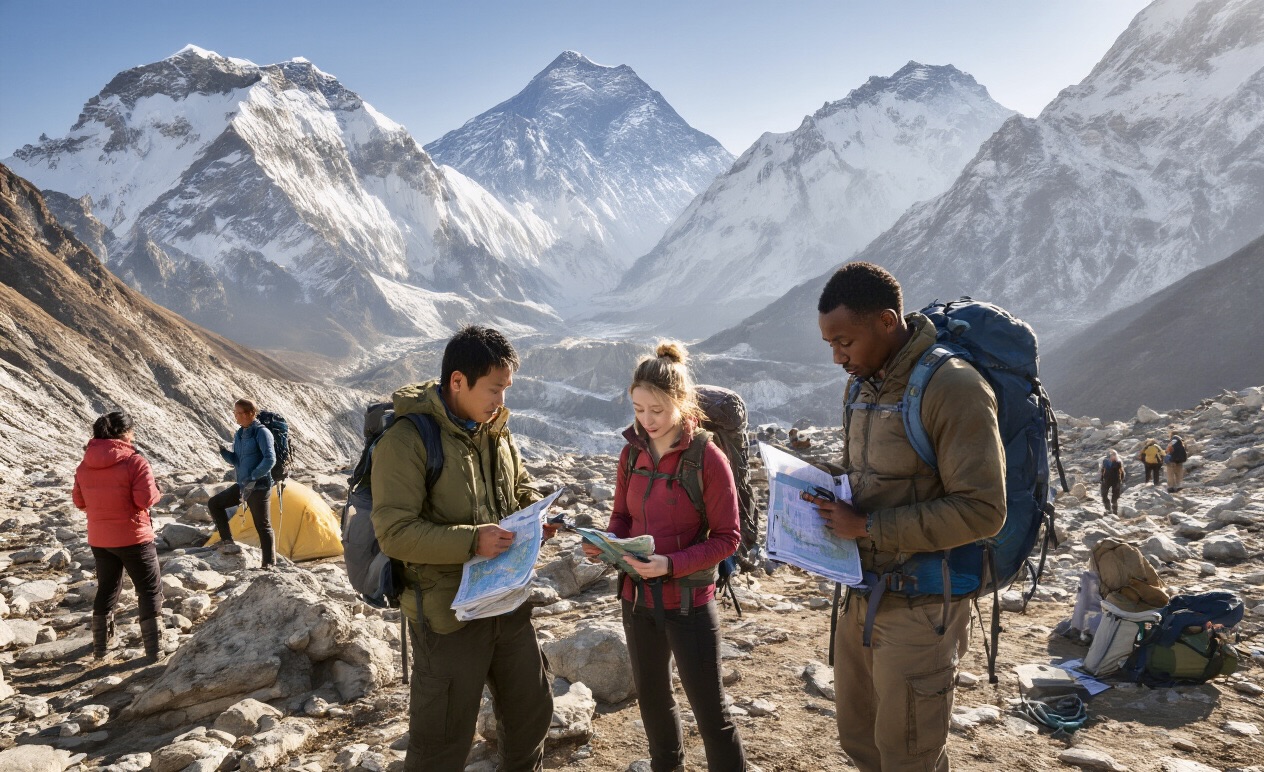
Evaluating Your Current Fitness Condition
The Everest Base Camp trek requires a moderate level of physical fitness, though you don't need to be a professional athlete. You'll be hiking for 5-8 hours daily over 12-14 days on steep, uneven terrain at high altitudes where oxygen levels are significantly lower. To evaluate if you're ready:
- Cardiovascular endurance: Can you engage in aerobic activities like running, cycling, or brisk walking for at least 60 minutes without excessive fatigue?
- Muscular strength: Do you have adequate leg, core, and lower back strength for steep ascents and descents?
- Stamina: Can you handle consecutive days of physical activity without requiring extensive recovery?
To assess your current condition, try a "test hike" with a loaded backpack on hilly terrain for 5-6 hours. Your performance will give you a realistic idea of areas needing improvement.
Previous High Altitude Trekking Experience
While prior high-altitude experience isn't mandatory for EBC, it provides valuable advantages:
- Altitude awareness: Previous exposure helps you recognize how your body personally responds to high elevations
- Mental preparation: Understanding the challenges of multi-day trekking helps set realistic expectations
- Acclimatization knowledge: Experience with proper acclimatization techniques reduces your risk of altitude sickness
If you have successfully completed treks above 3,000 meters (9,800 feet), you'll likely have a good foundation for the EBC trek. However, even without previous high-altitude experience, proper preparation can compensate for this gap.
Training Requirements for Different Routes
Different Everest Base Camp routes vary in difficulty, duration, and altitude profiles, requiring tailored preparation:
Standard Route via Lukla:
- 3-4 months of cardiovascular training (running, cycling, swimming)
- Strength training focusing on legs and core (squats, lunges, step-ups)
- Weekly long hikes with a loaded backpack, gradually increasing duration and elevation gain
Gokyo Lakes Route:
- 4-6 months of more intensive training due to higher elevations and challenging passes
- Enhanced focus on uphill climbing ability and stamina for longer trekking days
- High-altitude simulation training if possible
Three Passes Trek:
- 5-6 months of comprehensive training for this most challenging route
- Significant uphill climbing ability development
- Prior high-altitude trekking experience highly recommended
- Extensive strength and endurance training
For any route, incorporate interval training to build strength and endurance for long-duration activities. Practice on inclines to better simulate the terrain you'll face.
Age and Health Considerations
The Everest Base Camp trek welcomes trekkers across a wide age range, but certain health factors require special attention:
Age Considerations:
- Younger trekkers (teens to 20s): Focus on proper technique and pacing rather than speed
- Middle-aged trekkers (30s-50s): Pay special attention to joint health and recovery periods
- Older trekkers (60+): Extend training period by 1-2 months and focus on flexibility alongside strength
Health Considerations:
- Respiratory conditions: Consult with a physician specializing in high-altitude medicine before committing
- Cardiovascular issues: Obtain medical clearance and potentially undergo stress tests
- Joint problems: Strengthen supporting muscles and consider using trekking poles
- Chronic conditions: Develop a management plan with your doctor for medication and monitoring at altitude
Remember that mental toughness is equally important as physical conditioning. The trek involves long days in sometimes harsh weather conditions, where you'll face physical exhaustion. Developing a positive mindset and visualization techniques will help you stay focused through challenging sections.
A comprehensive health check-up is recommended for all trekkers, regardless of age or fitness level, before committing to the Everest Base Camp trek.
Determining Your Available Time and Budget

Duration Requirements for Each Route
The standard Everest Base Camp trek typically takes between 12 to 16 days, including necessary acclimatization days. These acclimatization days are crucial for adapting to high altitudes and should not be skipped to save time. Some trekkers opt for shorter itineraries (around 10 days), while others may extend their trek up to 25 days to include additional destinations like Gokyo Valley or high passes.
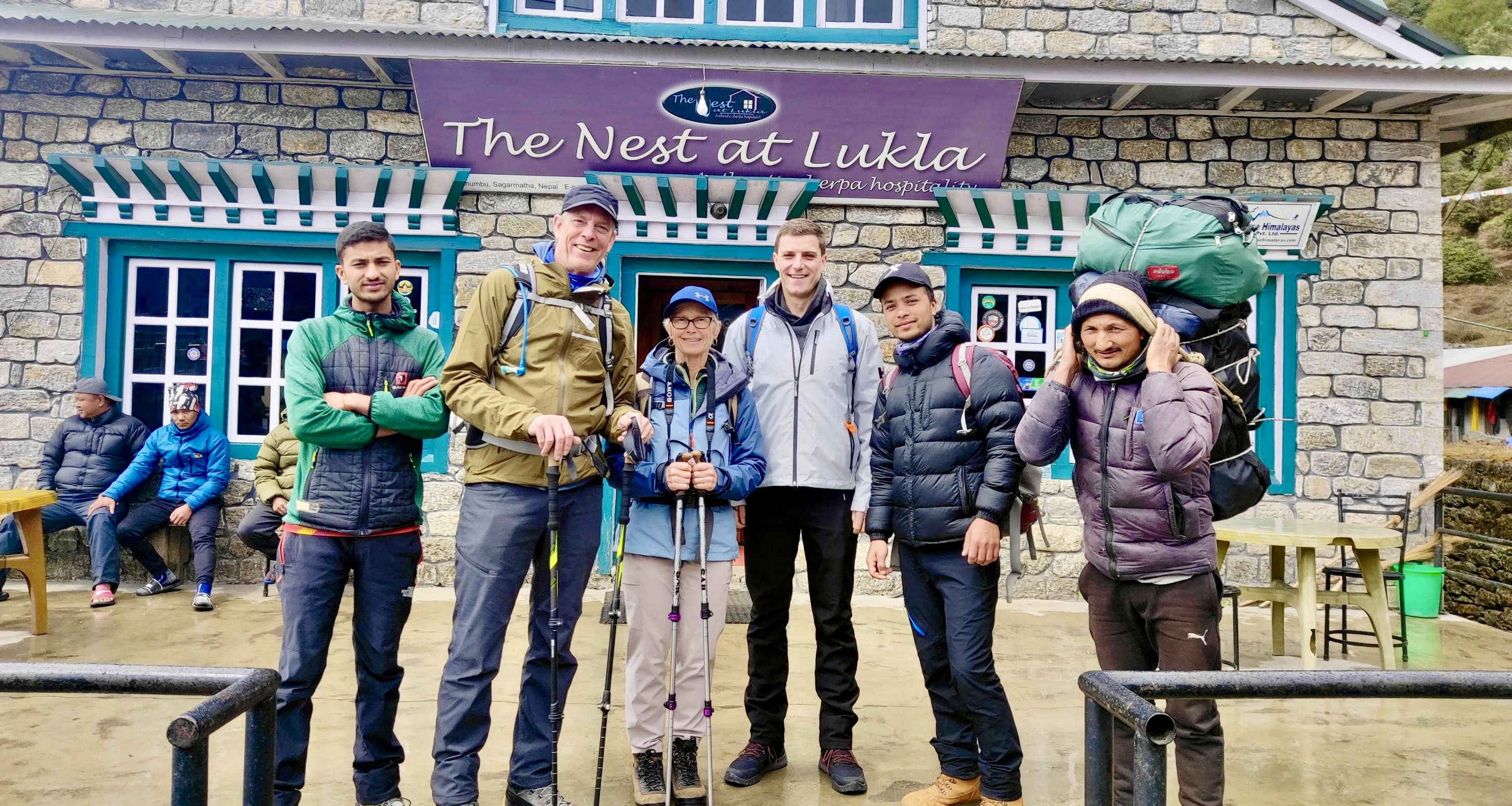
When planning your trek, remember that cutting corners on duration significantly increases the risk of altitude sickness and could jeopardize your chances of reaching Everest Base Camp successfully.
Cost Variations Between Different Paths
Different routes to Everest Base Camp come with varying price tags:
Standard EBC Trek: Costs approximately $1,200-$2,500 per person for a 12-day trek
Luxury Route Options: For those seeking more comfort, luxury EBC treks range from $3,000 to $10,000+ per person
Alternative Routes: Adding side trips to places like Gokyo Valley increases costs due to additional days of accommodation, food, and guide services
The choice between booking with local Nepalese operators versus international agencies also affects your budget:
Local operators: Generally more affordable (starting around $1,100)
International agencies: Higher cost ($1,400-$1,800) but often provide additional services and security
Seasonal Pricing Considerations
The timing of your trek significantly impacts costs:
Peak Seasons (Spring: February-May and Autumn: September-October):
- Higher accommodation rates
- Advanced booking required
- More stable and dry weather with clear views
- Busier trails with more trekkers
Off-Peak Seasons:
- Lower accommodation and service costs
- Less crowded trails
- More challenging weather conditions
- Potentially limited availability of services
Additional Expenses and Hidden Costs
Beyond the basic trek package, budget for these often-overlooked expenses:
Permits: $50-$100 total (Sagarmatha National Park permit: $30, TIMS: $10, Local Government Fees: $20)
Lukla Flights: Approximately $380 - $400 round-trip for foreign travelers
Equipment: $2,000 to purchase or $3-$5 per day to rent
Travel Insurance: Around $100-$300 (ensure coverage up to 5,500m altitude)
Emergency Helicopter Rescue: Up to $6,000 (should be covered by insurance)
Food and Drinks:
Meals: $25-$30 per day
Tea: Rs 150-250 per cup
Coffee: Rs 150-300 per cup
Bottled water: Rs 250-300
Hot water: Rs 20-100 per glass
Internet Access: $5-$8 per hour or $60 for a 600MB WiFi card
Tips for Guides and Porters: Customary 10% of trek cost (approximately $5-$8 per day for each staff member)
When calculating your total budget, remember that costs increase with altitude due to the logistical challenges of transporting supplies to remote locations.
Weather and Seasonal Factors for Route Selection
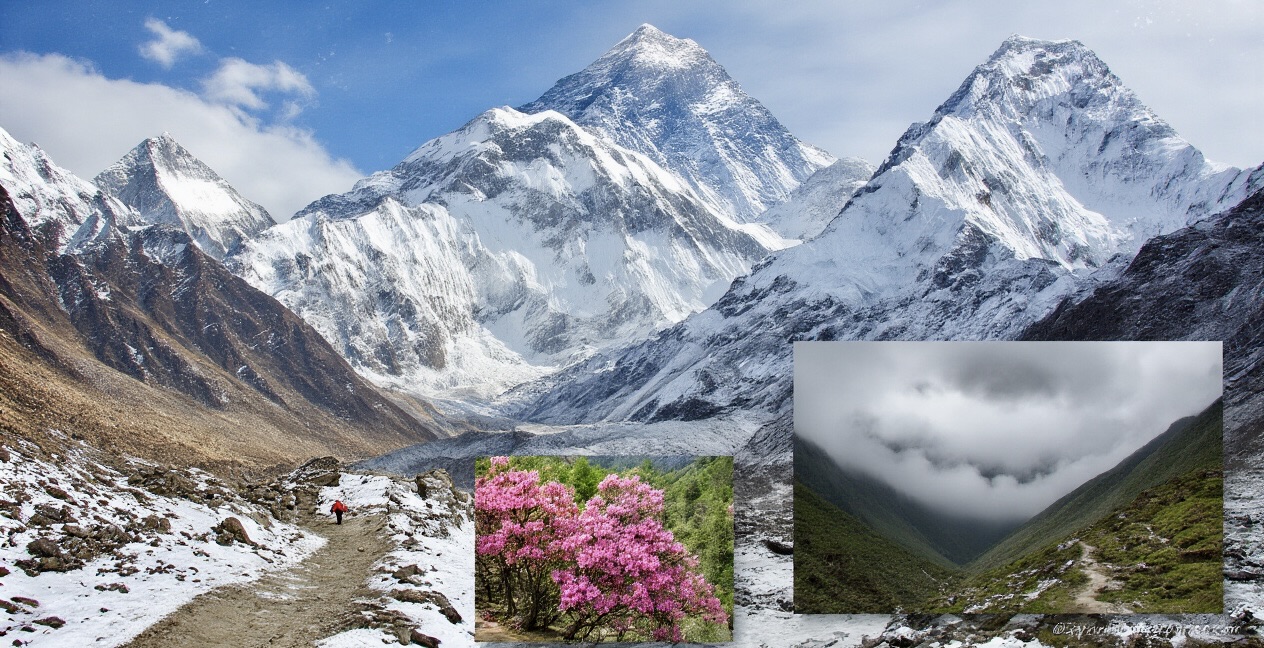
Best Months for Each Trekking Route
The Everest region experiences two distinct trekking seasons that are ideal for most routes:
- Pre-monsoon (Spring): February, March, April, and May
- Post-monsoon (Autumn): Late September, October, November, and December
For the classic Everest Base Camp trek, the optimal months are:
- March to May: Spring offers abundant sunny days with excellent visibility and beautiful rhododendron blooms
- Late September to November: Features stable weather, clear skies, and excellent mountain views
If you want to witness Everest Base Camp in full operation with climbers and tents, April and May are the best months as this coincides with the main Everest climbing season.
For those seeking quieter trails:
- Late February and March: Fewer trekkers but colder temperatures
- November and December: Crowds diminish while offering crisp, clear views
Monsoon and Winter Route Limitations
Monsoon Season (June, July, August):
- Significant flight delays or cancellations to/from Lukla
- Torrential rains, especially in lower elevations
- Higher risk of landslides along trekking routes
- Limited mountain visibility due to cloud cover
We advise against visiting during these months
Winter Season (January and February):
- Temperatures can drop to -20°C/-4°F to -30°C/-22°F at higher elevations
- Increased likelihood of snowfall blocking certain passes
- Requires additional time buffer for potential weather delays
- Necessitates specialized cold-weather gear and preparation
Weather-Related Safety Considerations
When planning your Everest Base Camp trek, consider these critical safety factors:
- Acclimatization: Regardless of season, proper acclimatization is essential for safety
- Weather pattern transitions: The fringe weeks of any season (late May or early September) can be unpredictable as weather patterns shift
- Alternative routes: During peak seasons, consider less-traveled paths to avoid overcrowding on main trails
- Extra days buffer: Include additional days in your itinerary, particularly during winter and monsoon months, to accommodate potential weather delays
- Flight disruptions: Weather conditions frequently affect flights to/from Lukla, requiring flexibility in your travel schedule
Visibility and Mountain Views by Season
Different seasons offer varying quality of mountain views:
Spring (March-May):
- Abundant sunny days with excellent visibility
- Late April and May can sometimes experience heat haze
- Colorful landscapes with rhododendron blooms enhancing scenery
Autumn (September-November):
- Late October and November provide the most stable weather
- Minimal cloud cover with crisp, clear mountain views
- Less heat haze compared to late spring months
Winter (December-February):
- Colder temperatures typically bring crisper and clearer mountain views
- Excellent photography opportunities on clear days
- Less atmospheric distortion for viewing distant peaks
Monsoon (June-August):
- Mountain views frequently obscured by clouds and precipitation
- Lower elevations appear lush and green
- Occasional clearing may offer dramatic views between cloud systems
For photographers seeking the clearest mountain vistas, late October through December generally provides the most consistent visibility conditions with less heat haze and cloud interference.
Altitude Acclimatization and Safety Considerations
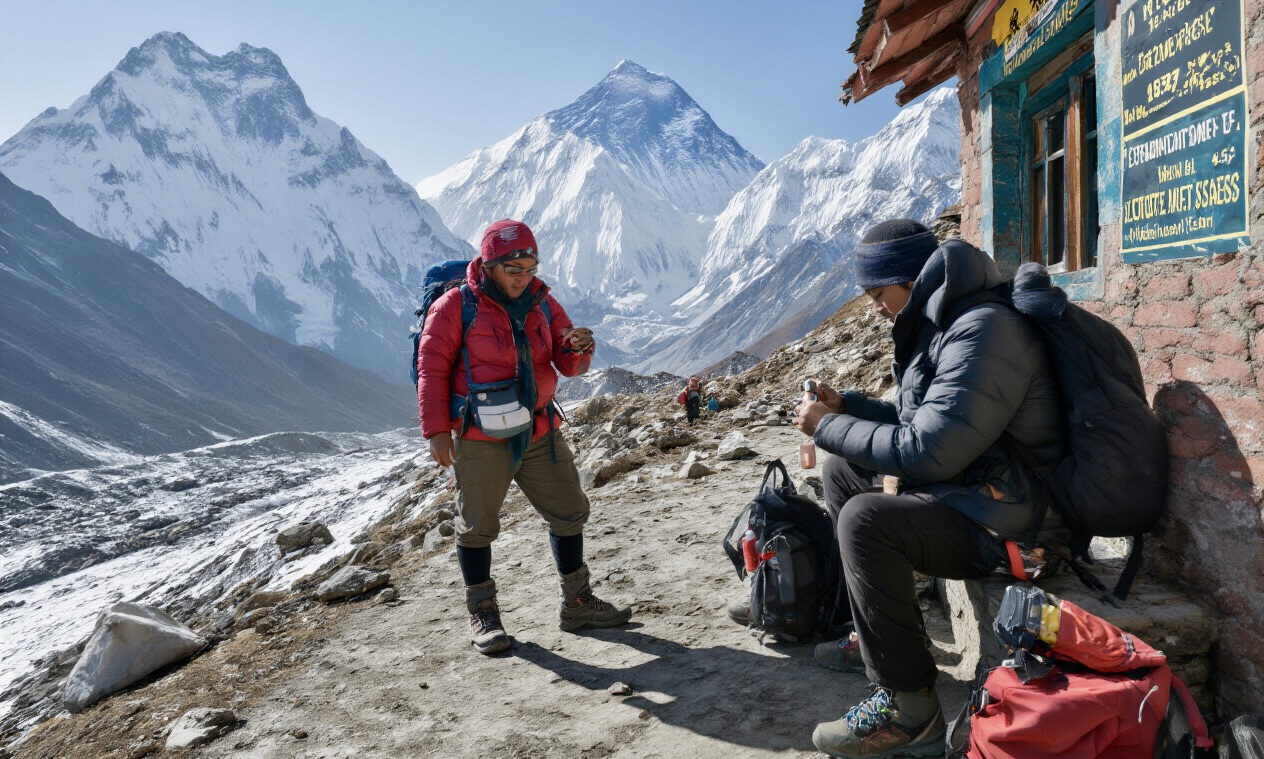
Altitude Gain Profiles of Different Routes
Altitude sickness can occur at elevations above 2,500m, making it a significant concern for Everest Base Camp trekkers since the journey starts at Lukla (2,800m) and reaches over 5,000m. Different EBC routes have varying altitude gain profiles, which directly impact your acclimatization process.
The standard EBC trek route includes critical altitude jumps, particularly from Phakding (2,610m) to Namche Bazaar (3,440m) - an elevation gain that puts most trekkers into the altitude sickness risk zone. When selecting your route, examine the daily altitude gains carefully. Routes with gentler ascent profiles allow your body to produce more red blood cells and adjust to the decreasing oxygen levels more effectively.
Acclimatization Rest Days Planning
Proper acclimatization is essential for a successful trek to Everest Base Camp. When planning your journey:
- Include at least one acclimatization day in Namche Bazaar (3,440m)
- For longer routes like the Three Passes trek, plan a second acclimatization day at Chhukung (4,730m)
- Remember that acclimatization days aren't idle days - they're active rest days
The "climb high, sleep low" strategy is particularly effective. During your rest day in Namche Bazaar, consider hiking to Hotel Everest View (3,962m) before returning to sleep at Namche's lower elevation. This practice helps your body adjust to higher altitudes while recovering at a safer elevation overnight.
Altitude Sickness Risk Assessment
Altitude sickness affects approximately 75% of trekkers on the day they reach Namche Bazaar or shortly thereafter. Important factors to consider:
- Altitude sickness can affect anyone regardless of age, sex, or physical fitness
- Common symptoms include shortness of breath, fatigue, nausea, headaches, dizziness, loss of appetite, and disturbed sleep
- The risk increases significantly above 3,000m
- Previous high-altitude experience doesn't guarantee immunity
Assess your personal risk factors honestly. If you've experienced severe altitude sickness before, consider routes with more gradual ascent profiles and additional acclimatization days.
Emergency Evacuation Accessibility
In cases of severe Acute Mountain Sickness (AMS), immediate descent is the primary treatment. When selecting your route, consider:
- Accessibility of lower elevations in case of emergency
- Proximity to helicopter evacuation points
- Communication availability for emergency services
Helicopter evacuations are possible but extremely expensive. Ensure your travel insurance covers high-altitude medical evacuations before departing. Your trekking guide should be trained to recognize AMS symptoms and will advise when descent is necessary - always heed this advice as AMS can be fatal if ignored.
Remember that the safest approach is prevention through proper acclimatization. Routes with better evacuation accessibility provide an additional safety net, but they should not replace careful planning and respect for altitude-related risks.
Accommodation and Facilities Along Routes
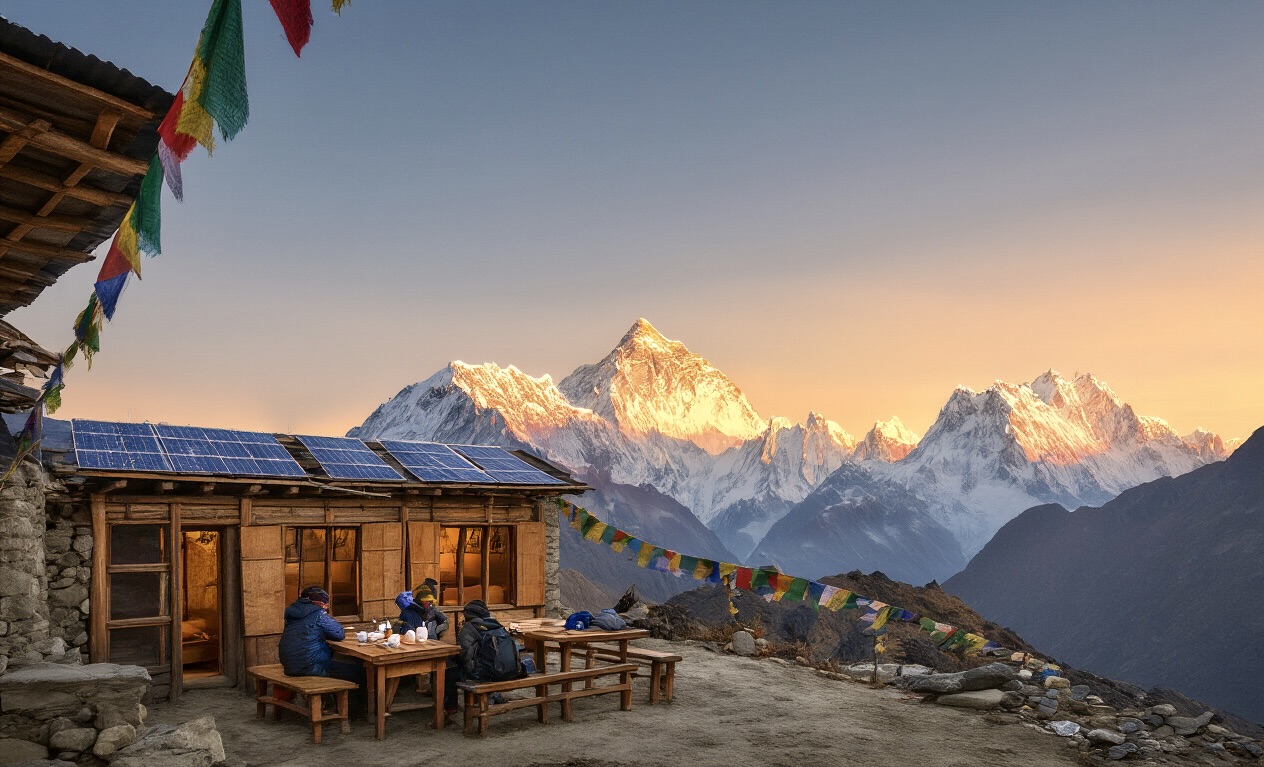
Teahouse Availability and Quality
Teahouses are the most popular accommodation option on the Everest Base Camp trek. These small, family-run establishments function as bed-and-breakfast hotels dotted along the trekking routes. They offer basic amenities including beds, meals, and sometimes hot showers and electricity.
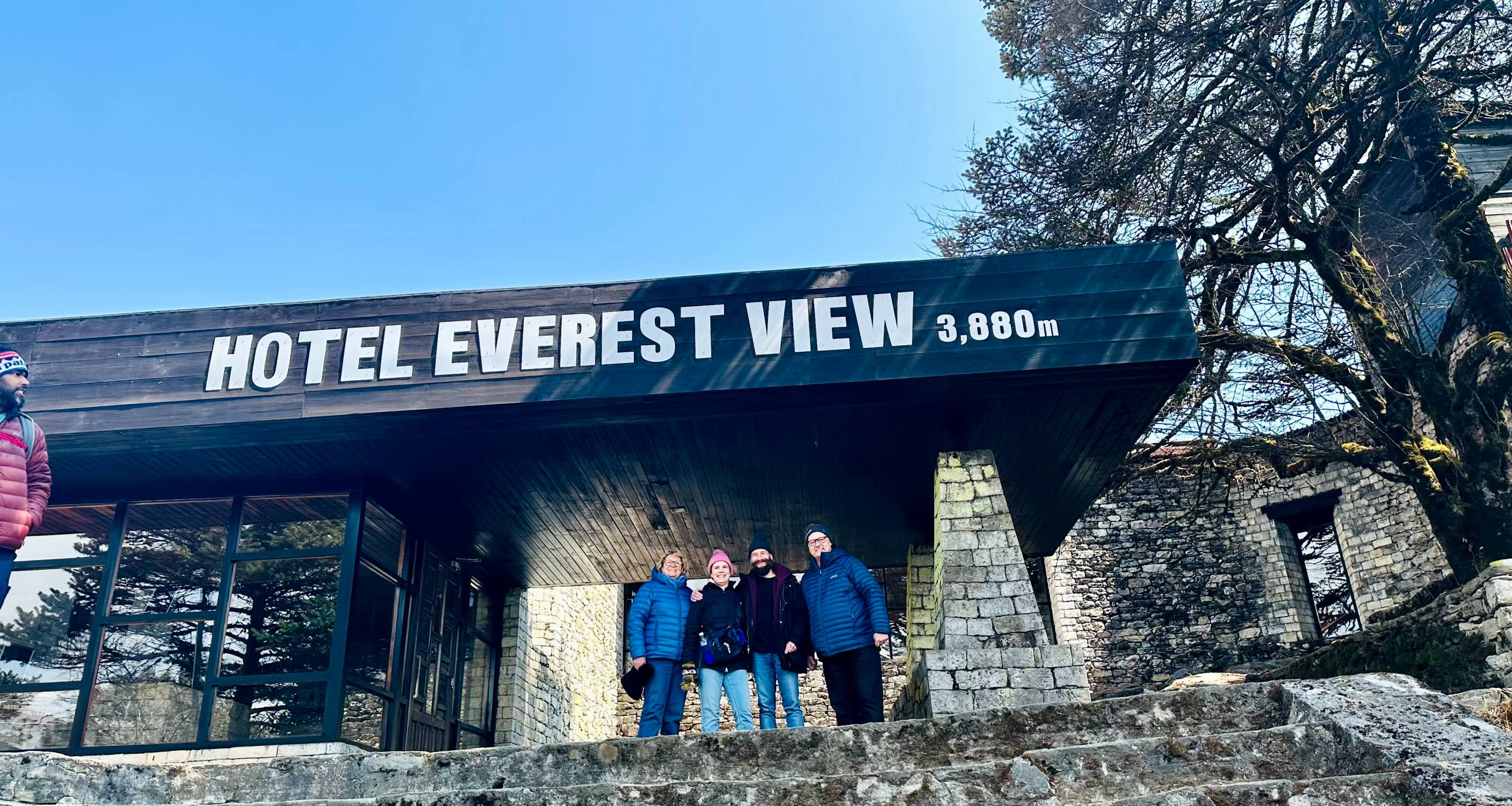
The quality and facilities of teahouses vary significantly depending on their location:
- Lower altitude locations (Lukla, Phakding, Namche Bazaar): More comfortable options with flush toilets, hot water showers, and reliable electricity
- Higher altitude locations (Lobuche, Gorakshep): Simpler facilities with shared bathrooms, manual flushing toilets or long drops, and limited electricity
Pricing also varies by location:
- Lower altitude: $5-$60 per night
- Higher altitude: $7-$50 per night
In Namche Bazaar, a major acclimatization stop, you'll find the widest variety of accommodations, from basic teahouses to higher-end options. Popular teahouses include The Nest, Hotel Camp de' Base, and Hotel Sherpaland.
Luxury Lodge Options on Different Paths
For trekkers seeking more comfort, several luxury lodge options exist along the main EBC route:
- Mountan Lodges of Nepal: Available in several locations including Lukla, Phakding, and Namche Bazaar, offering higher-end amenities
- The Everest View Hotel: Located near Namche Bazaar, this premium option can cost up to $350 per night
Hotel Himalayan and Hotel Tashi Delek in Tengboche offer more comfortable options at moderate altitudes
Luxury lodges typically provide:
- Private bathrooms with hot showers
- More reliable electricity and charging facilities
- Higher quality bedding and better insulation
- Enhanced dining options
Camping Requirements for Remote Routes
While teahouses dominate the main EBC route, some remote variants may require camping. When camping:
- Bring your own sleeping bag for comfort and warmth
- A tour operator can arrange camping equipment and porters
- Camping allows access to less-traveled areas but requires more preparation
- Many trekkers prefer teahouse trekking as it provides better cultural immersion and opportunities to meet fellow trekkers
Even when staying in teahouses, bringing a personal sleeping bag is recommended for hygiene and additional warmth, especially at higher altitudes.
Communication and Charging Facilities
Communication and device charging options vary along the trek:
- Electricity access: Most teahouses have electricity for lighting and limited charging
- Charging costs: $3-5 per hour for device charging, usually in communal areas
- Internet connectivity: Some teahouses offer Wi-Fi hotspots at additional cost
- Mobile coverage: Surprisingly good throughout the region; purchasing a 3G SIM card before the trek is recommended
- Reliability: Both electricity and the internet become less reliable as altitude increases
Popular communication points are in larger settlements like Namche Bazaar, where multiple teahouses offer more reliable charging and internet options.
For a stress-free experience, trekking with a reputable tour operator is recommended as they can pre-book accommodations and ensure you stay in reliable teahouses with the best available facilities.
Scenic Highlights and Cultural Experiences
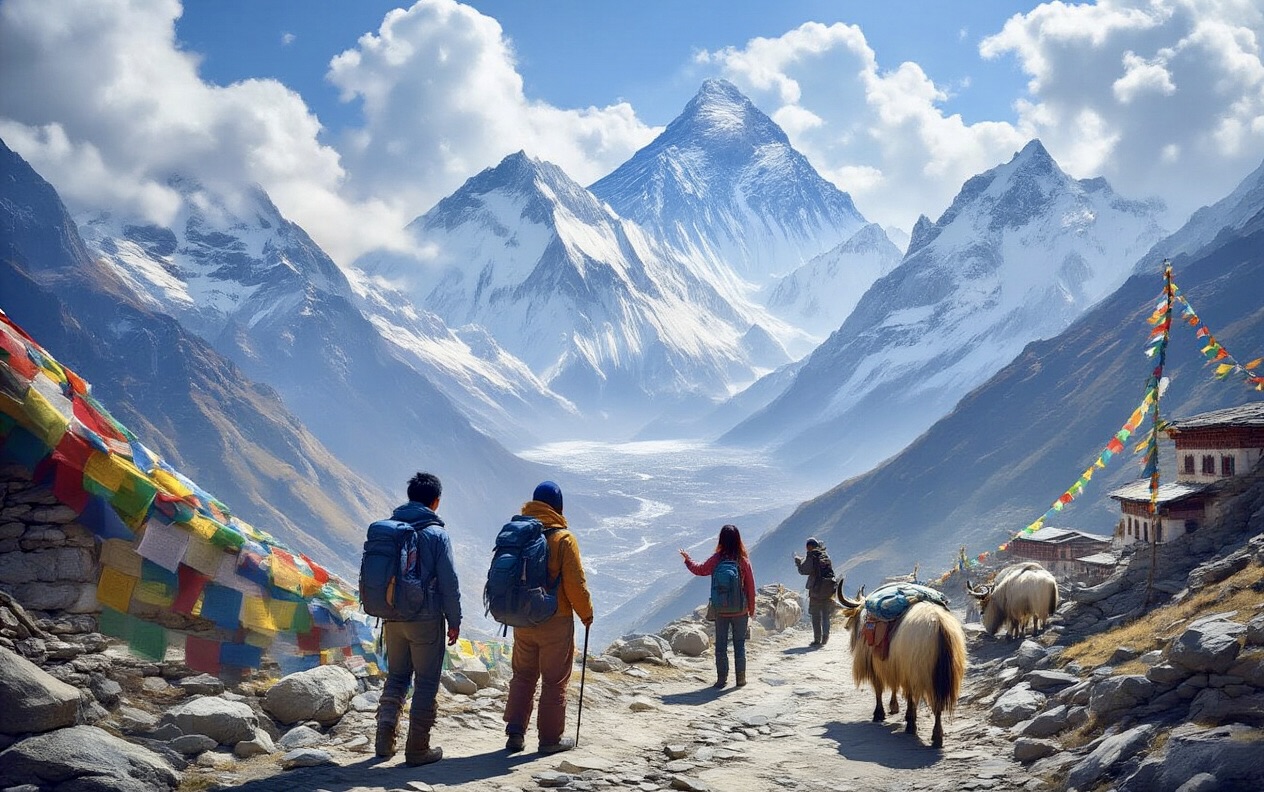
Mountain Views and Photography Opportunities
The Everest region offers unparalleled mountain vistas that make it a photographer's paradise. Along your trek, you'll witness breathtaking panoramas of the world's highest peaks. From Namche Bazaar, you can capture stunning views of Thamserku (6,608m), Ama Dablam (6,812m), Kong Ri (6,186m), and glimpses of Everest (8,850m).
The Everest View Hotel, perched at 3,880m, provides one of the most magnificent viewpoints along the trek. This location offers mesmerizing views of Everest, Lhotse, and Ama Dablam, allowing for spectacular photography opportunities with minimal physical exertion during your acclimatization day.
Kala Patthar (5,545m) stands as the premier photography spot on the entire trek. This "Black Rock" provides the closest and most unobstructed views of Mount Everest's summit, along with panoramic vistas of Nuptse, Lhotse, and Changtse. Many trekkers time their ascent for sunrise or sunset when the golden light creates magical conditions for photography.
Sherpa Culture and Monastery Visits
The Everest Base Camp trek offers deep immersion into the rich Sherpa culture that makes this journey truly special. Namche Bazaar serves as the cultural crossroads of the Khumbu region, where you can visit the Sherpa Museum to learn about local history, traditions, and mountaineering achievements. The Saturday market in Namche continues a centuries-old tradition where locals trade everything from fresh produce to handwoven textiles.
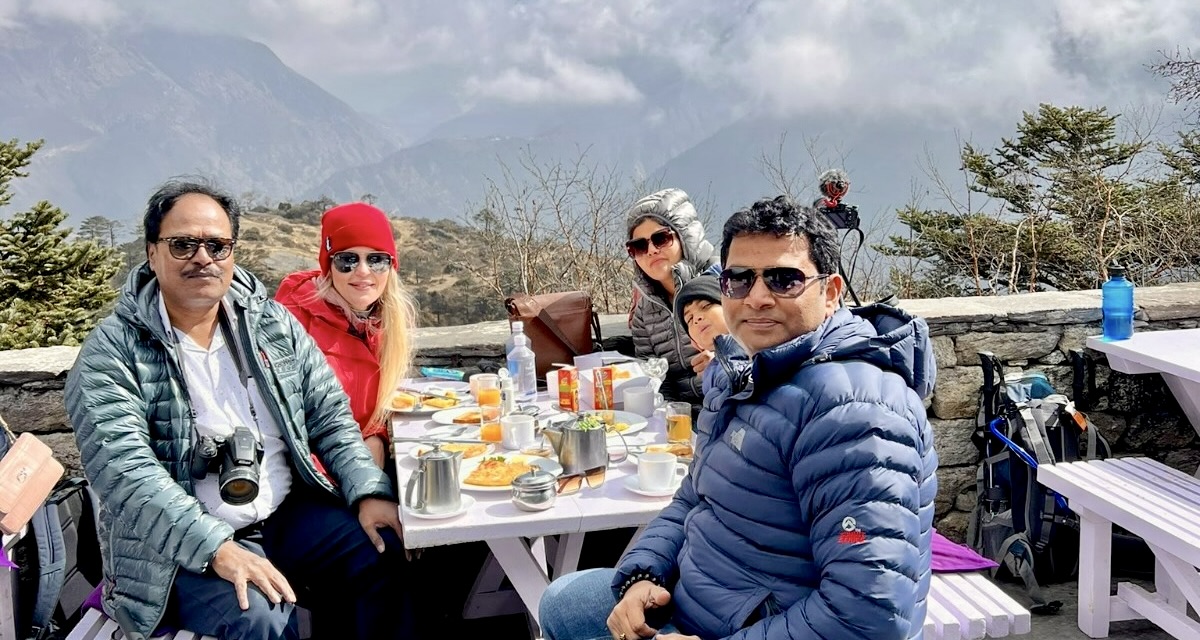
Tengboche Monastery stands as the spiritual center of the region at 3,867 meters. This iconic cultural landmark is set against the backdrop of Ama Dablam and offers visitors the chance to:
- Witness morning prayers with monks chanting mantras
- Experience the Mani Rimdu festival (if your trek aligns with this annual celebration)
- Observe Buddhist mask dances and rituals symbolizing the victory of Buddhism
The oldest Sherpa village in Khumbu, Pangboche, houses a monastery built in the 17th century that holds significant spiritual importance. Throughout your journey, you'll encounter mani walls with Buddhist mantras like "Om Mani Padme Hum" and colorful prayer flags representing different elements: blue (sky), white (air), red (fire), green (water), and yellow (earth).
Unique Landscapes and Natural Features
The Everest Base Camp trek traverses through Sagarmatha National Park, a UNESCO World Heritage Site, showcasing diverse landscapes that change dramatically as you ascend. From lush forests in the lower regions to the stark beauty of the alpine zone, the route offers constant visual surprises.
The Khumbu Glacier, one of the world's largest glaciers, presents an otherworldly landscape of ice formations, seracs, and moraine fields. This massive river of ice flows down from Everest and creates a unique terrain unlike anything you'll see elsewhere.
The trail crosses numerous suspension bridges spanning deep gorges, with the Hillary Suspension Bridge being particularly impressive. Stretching over the Dudh Koshi River at an elevation of 3,800m, it offers exhilarating views and photo opportunities while connecting different parts of the trekking route.
Wildlife and Flora Viewing Chances
Sagarmatha National Park hosts diverse flora and fauna adapted to high-altitude environments. While wildlife sightings require patience and good timing, trekkers may encounter:
- Himalayan tahr (wild mountain goats)
- Musk deer in forested areas
- Various bird species including the colorful Danphe (Nepal's national bird)
- If extremely fortunate, a glimpse of the elusive snow leopard
The flora changes dramatically with altitude. In lower regions (2,000-3,000m), you'll walk through forests of rhododendron, pine, and fir trees, which are particularly spectacular during spring when rhododendrons bloom in vibrant colors. As you ascend, the vegetation transitions to hardy alpine species, dwarf rhododendrons, and eventually gives way to lichens and mosses at higher elevations.
During spring (March-May), wildflowers create colorful carpets across hillsides, offering stunning foreground elements for landscape photography. The changing vegetation zones provide a visual record of your journey from the relatively lush middle hills to the stark beauty of the high Himalaya.
Permits and Documentation Requirements
Obtaining the correct permits is essential for your Everest Base Camp trek. The documentation requirements ensure your safe and legal access to this UNESCO World Heritage Site while helping preserve its natural resources.
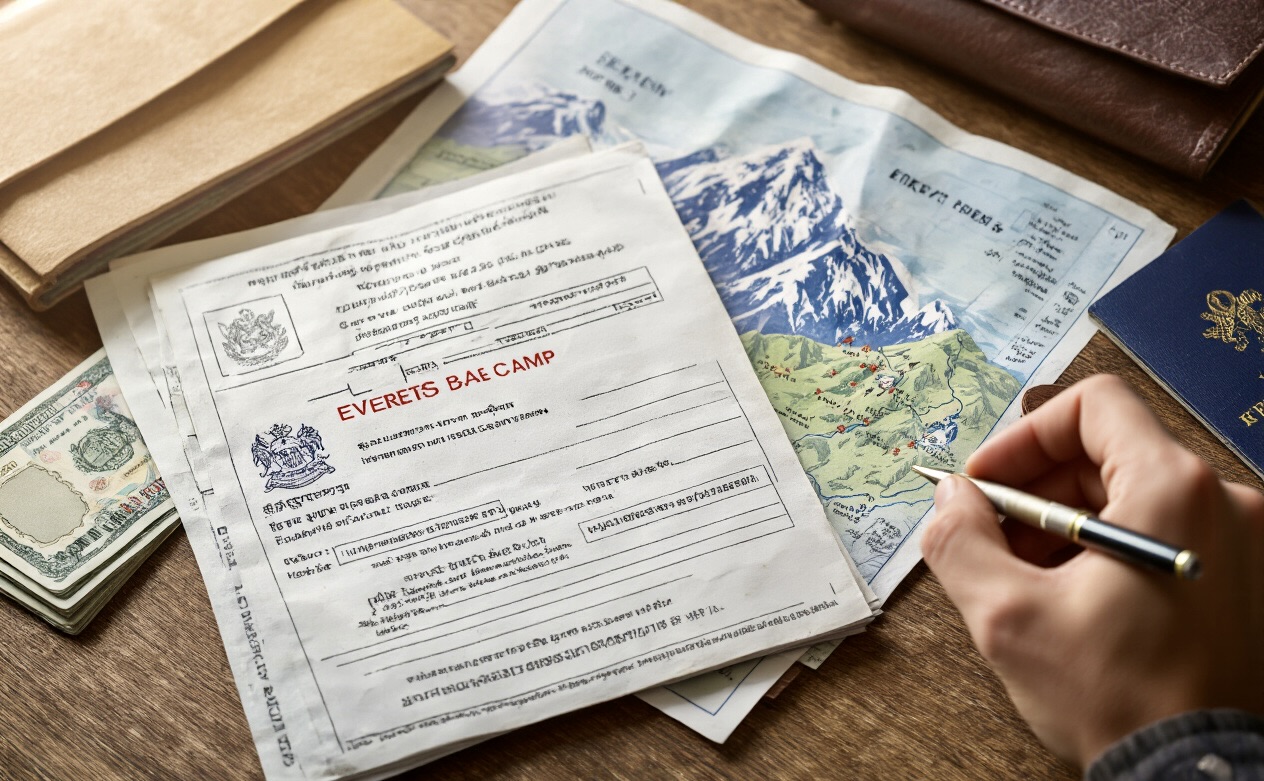
Sagarmatha National Park Entry Permits
All trekkers must obtain a Sagarmatha National Park Entry Permit since Everest Base Camp lies within this protected area. The permit costs:
- Foreign nationals: NPR 3,000 per person (plus 13% VAT)
- SAARC nationals: NPR 1,500 per person (plus VAT)
- Nepali citizens: NPR 100 per person
- Children under 10 years: Free entry
You can acquire this permit from:
- Nepal Tourism Board Office in Kathmandu (recommended, especially during peak season)
- Sagarmatha National Park Entry Gate in Monjo
- Your passport is required to obtain this permit.
TIMS Card Regulations
As of October 1, 2018, the Trekkers Information Management System (TIMS) card is no longer required for the Everest Base Camp Trek. The Khumbu Pasang Lhamu Rural Municipality Entrance Permit has replaced it.
This permit costs NPR 2,000 per person for the first four weeks for all foreign nationals, including SAARC citizens. After four weeks, the cost increases to NPR 2,500 per person (no VAT applicable).
You can obtain this permit:
- After arriving in Lukla (for those flying in)
- At the Sagarmatha National Park Counter in Monjo (for trekkers arriving from Jiri or Salleri)
- Note that there are no offices in Kathmandu that issue this particular permit.
Special Permits for Restricted Areas
If you're taking alternative routes to Everest Base Camp, additional permits may be required:
For trekkers hiking from Jiri to Everest Base Camp, a Gaurishankar Conservation Area Permit is mandatory, as this route traverses through a protected area. This permit costs NPR 3,000 per person and can be obtained at the Nepal Tourism Board in Kathmandu.
Established in January 2010, the Gaurishankar Conservation Area is home to 565 plant species, 35 mammal species, and numerous other wildlife that require protection.
Insurance and Medical Certificate Needs
While not explicitly mentioned as permit requirements, comprehensive travel insurance with high-altitude trekking coverage is essential for the Everest Base Camp Trek. Your insurance should cover:
- Medical emergencies
- Helicopter evacuation (up to 6,000 meters)
- Trip cancellation
- Lost or stolen belongings
All trekkers must carry their passports, a valid visa, and permit documentation throughout the trek, as they may be checked at various checkpoints.
Remember that all permit fees must be paid in Nepali Rupees, not US dollars or other currencies. Local guides are exempt from permit requirements when accompanying trekkers.
Choosing the Right Trekking Company and Guide
When planning your Everest Base Camp trek, selecting the right trekking company and guide is as crucial as choosing the proper route. This decision significantly impacts your overall experience, safety, and enjoyment during the journey.

Luxury Holidays Nepal Service Advantages
Luxury Holidays Nepal stands out among trekking companies with its comprehensive approach to Everest region treks. They specialize in blending adventure with comfort, offering premium trekking experiences that include:
- Luxury accommodations along the trekking route
- Helicopter transfer options to minimize walking time
- Personalized itineraries tailored to your preferences and needs
- Exceptional customer service before, during, and after your trek
- Comprehensive pre-trek preparation support
- 24/7 assistance during your journey
Their services are designed for travelers who seek to experience the majesty of the Himalayas without compromising on comfort and quality.
Guide Qualifications and Experience
The quality of your trekking guide can make or break your Everest Base Camp experience. When assessing guides, look for:
- Government licensing: All guides should be officially licensed by the Nepal government
- Experience in the Everest region: Prioritize guides with extensive experience specifically on the routes you're considering
- Language proficiency: Ensure your guide speaks English or your preferred language fluently
- First aid certification: Guides should be trained in wilderness first aid and high-altitude medical emergencies
- Knowledge of local culture: The best guides offer insights into Sherpa culture and traditions
- Client testimonials: Review previous trekkers' experiences with specific guides
Luxury Holidays Nepal's guides typically have 5+ years of experience leading treks in the Everest region and receive ongoing training in safety protocols and customer service.
Group Size and Personalized Attention
The size of your trekking group directly affects the level of personalized service you'll receive:
- Small group advantages: Groups of 2-8 trekkers allow for more customized pacing and individual attention
- Private treks: For maximum flexibility, consider a private trek with a dedicated guide
- Guide-to-client ratio: Look for companies that maintain a ratio of at least 1 guide per 4-5 trekkers
- Support staff: Premium trekking companies provide adequate porters to ensure guides can focus on your experience and safety
Luxury Holidays Nepal offers both small group departures and fully customizable private treks with optimal guide-to-client ratios.
Equipment and Safety Standards
Safety should be your top priority when selecting a trekking company for the Everest region:
- Quality equipment: Verify the company provides or recommends appropriate gear for high-altitude trekking
- Communication devices: Guides should carry reliable satellite phones or communication devices for emergencies
- Oxygen supplies: For higher routes, emergency oxygen should be available
- Evacuation protocols: The company should have established evacuation procedures and insurance requirements
- Acclimatization schedule: Their itineraries should include proper acclimatization days
- Weather monitoring: Guides should have access to current weather information
Luxury Holidays Nepal maintains stringent safety standards and regularly updates its equipment and protocols to ensure trekker wellbeing throughout the journey.
Final Route Selection Criteria

Matching Route Difficulty to Your Abilities
After evaluating all possible Everest Base Camp trek routes, it's crucial to honestly assess your physical capabilities against each route's difficulty level. The classic EBC trek is considered moderate to challenging, making it accessible for reasonably fit trekkers with proper preparation. For those seeking greater challenges, routes incorporating high passes like Cho La, Renjo La, or Kongma La are rated as challenging to very challenging.
Consider your high-altitude trekking experience and endurance level. First-time high-altitude trekkers should generally opt for the classic 12-day route with its well-planned acclimatization days, while experienced mountaineers might find the Three Passes trek (crossing all three major passes) more rewarding despite its very challenging nature.
Balancing Adventure with Comfort Preferences
Your personal comfort requirements play a significant role in route selection. The classic route offers the best infrastructure with established teahouses, relatively comfortable accommodations, and reliable facilities. As you venture onto alternative routes like Gokyo Lakes or the Three Passes trek, accommodations become more basic and amenities more limited.
Consider how important certain comforts are to your trekking experience:
- Do you require private rooms or are dormitory-style accommodations acceptable?
- Can you manage with basic washing facilities and occasional lack of hot water?
- Are you comfortable with limited menu options in more remote areas?
- How important is having reliable electricity for charging devices?
The more remote and challenging routes offer increased solitude and pristine landscapes but require sacrificing certain comforts that are available on the classic route.
Optimizing Time Versus Experience Trade-offs
Your available time will significantly influence your route choice. Options range from the 7-day helicopter return trek (challenging due to rapid ascent) to the comprehensive 18-day Three Passes journey. The classic 12-day trek represents the optimal balance for many trekkers.
When evaluating time constraints:
- Shorter treks (7-10 days) compromise on acclimatization time, increasing altitude sickness risks
- The classic 12-day trek provides adequate acclimatization with efficient routing
- Longer routes (15-18 days) offer more comprehensive experiences but require additional vacation time
- Consider including buffer days for potential weather delays, especially with Lukla flights
Remember that rushing the journey significantly diminishes the experience and increases health risks, so it's better to choose a shorter route than to compress a longer itinerary.
Making the Ultimate Decision for Your EBC Journey
With all factors considered, your final decision should align with your personal trekking philosophy. Ask yourself what matters most:
- Is reaching EBC your primary goal, or do you value the journey equally?
- Are you seeking solitude or do you appreciate the camaraderie of other trekkers?
- Do you prioritize cultural experiences or natural landscapes?
- How important is photography and capturing diverse scenery?
Many experienced trekkers consider the classic route the definitive best choice because it offers "the perfect balance of challenge and comfort" while providing "effective acclimatization" through its well-established itinerary. However, for those seeking additional challenges and more diverse landscapes, the Gokyo Lakes route offers stunning mountain lakes while the Three Passes trek provides the most comprehensive Himalayan experience.
Ultimately, there is no universally "best" route - only the best route for your specific circumstances, abilities, and preferences. Choose the path that will create your most meaningful Everest experience.
Final Thoughts on Choosing Your EBC Trek Route
Selecting the right Everest Base Camp trek route is a deeply personal decision that depends on your fitness level, available time, budget, and what you hope to experience in the Himalayas. Whether you choose the classic route, the Gokyo Lakes variation, or one of the less-traveled paths, proper preparation is key to a successful journey. Consider the seasonal factors, acclimatization needs, and accommodation options that align with your preferences.
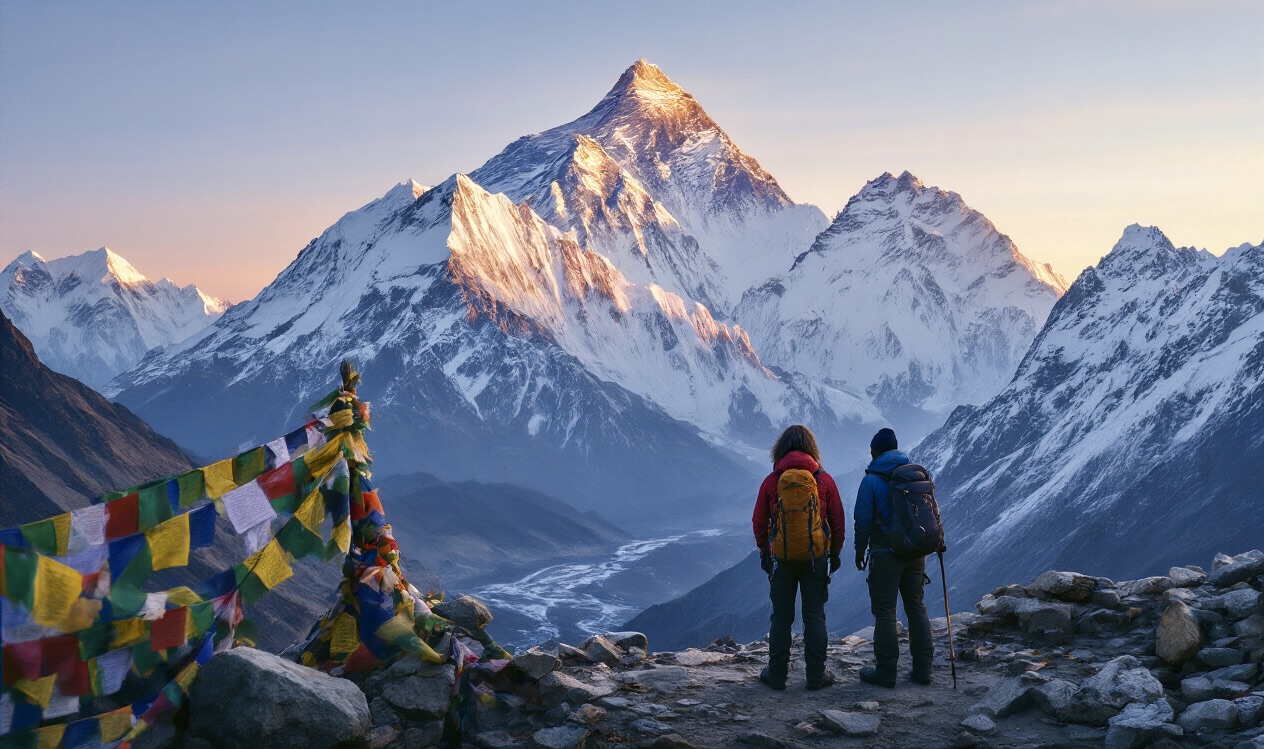
Remember that this adventure is as much about the journey as the destination. Take time to research your trekking company thoroughly, ensure all permits are in order, and prepare both physically and mentally for the challenges ahead. The perfect EBC trek route isn't necessarily the most popular one—it's the one that matches your abilities and allows you to fully embrace the majestic beauty and rich cultural heritage of the Everest region. Whatever path you choose, the memories of standing beneath the world's highest peak will stay with you long after you've returned home.
If you need any further information, please contact us by email: [email protected], Phone: +977 985 100 5129 (WhatsApp)

